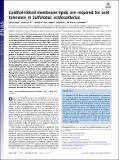Calditol-linked membrane lipids are required for acid tolerance in Sulfolobus acidocaldarius
Author(s)
Zeng, Zhirui; Liu, Xiao-Lei; Wei, Jeremy H.; Summons, Roger E; Welander, Paula V.
DownloadPublished version (805.8Kb)
Terms of use
Metadata
Show full item recordAbstract
Archaea have many unique physiological features of which the lipid composition of their cellular membranes is the most striking. Archaeal ether-linked isoprenoidal membranes can occur as bilayers or monolayers, possess diverse polar head groups, and a multiplicity of ring structures in the isoprenoidal cores. These lipid structures are proposed to provide protection from the extreme temperature, pH, salinity, and nutrient-starved conditions that many archaea inhabit. However, many questions remain regarding the synthesis and physiological role of some of the more complex archaeal lipids. In this study, we identify a radical S-adenosylmethionine (SAM) protein in Sulfolobus acidocaldarius required for the synthesis of a unique cyclopentyl head group, known as calditol. Calditol-linked glycerol dibiphytanyl glycerol tetraethers (GDGTs) are membrane spanning lipids in which calditol is ether bonded to the glycerol backbone and whose production is restricted to a subset of thermoacidophilic archaea of the Sulfolobales order within the Crenarchaeota phylum. Several studies have focused on the enzymatic mechanism for the synthesis of the calditol moiety, but to date no protein that catalyzes this reaction has been discovered. Phylogenetic analyses of this putative calditol synthase (Cds) reveal the genetic potential for calditol–GDGT synthesis in phyla other than the Crenarchaeota, including the Korarchaeota and Marsarchaeota. In addition, we identify Cds homologs in metagenomes predominantly from acidic ecosystems. Finally, we demonstrate that deletion of calditol synthesis renders S. acidocaldarius sensitive to extremely low pH, indicating that calditol plays a critical role in protecting archaeal cells from acidic stress. ©2018 National Academy of Sciences. All rights reserved.
Date issued
2018-12Department
Massachusetts Institute of Technology. Department of Earth, Atmospheric, and Planetary SciencesJournal
Proceedings of the National Academy of Sciences of the United States of America
Publisher
Proceedings of the National Academy of Sciences
Citation
Zeng, Zhirui et al., "Calditol-linked membrane lipids are required for acid tolerance in Sulfolobus acidocaldarius." Proceedings of the National Academy of Sciences of the United States of America 115, 51 (December 2018): p. 12932-12937 doi. 10.1073/pnas.1814048115 ©2018 Authors
ISSN
1091-6490